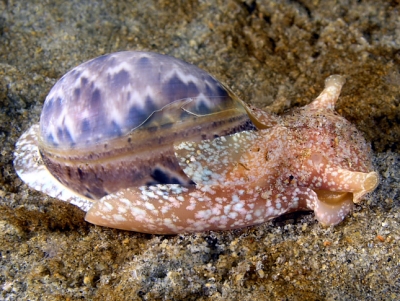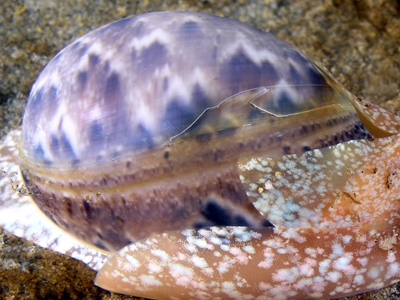Gould's Bubble Snail - shell damage
May 3, 2006
From: Kevin Lee

Hi Doc,
On completing a recent dive at La Jolla Shores Canyon, I came across hundreds of snails on the sandy bottom, crawling amongst large patches of green algae. On closer inspection, it seemed the rhinophores resembled those of some nudibranchs. Thus, I snapped some fotos and, shazaam, on arriving home, and consulting Behrens' book (EPN), discovered the critter is indeed an opistobranch, Bulla gouldiana (Gould's Bubble Snail). Mistook it first as Bulla punctuolata.
Locality: La Jolla Shores Canyon, approx 25 feet, California, USA, Eastern Pacific, 06 April 30, sandy bottom, with patches of green algae. Length: approx 1.75 inches. Photographer: Kevin Lee.
Then searching the SeaSlugForum, was happy to learn that a friend, Barbara Lloyd, (whom I've not met yet), already posted some nice fotos [message #16369 ]. I submit another to show the beauty of the shell (might you know if the visible cracks signify a natural process or damage?).
Best regards,
K:-)
diverkevin@gmail.com
Kevin Lee, 2006 (May 3) Gould's Bubble Snail - shell damage. [Message in] Sea Slug Forum. Australian Museum, Sydney. Available from http://www.seaslugforum.net/find/16504
Dear Kevin,
If you have by chance a photo showing a whole 'herd' of Bulla it would be nice to add to the Forum. Species of Bulla seem to one of the opisthobranch groups which either are present in large numbers or not at all.
The shell damage in your photo is 'natural' in the sense of Lord Tennyson's " Nature, red in tooth and claw ..." I suspect a fish or more likely, a crab, has been trying to get at the animal by breaking away the lip of the shell. Fortunately Bulla has still retained a shell big enough and strong enough for the animal to be able to retract inside far enough to escape hungry predators. The reason the new shell, which has grown to replace the old damage, is a different colour pattern, is that the edge of the mantle must have been slightly damaged as well. The mantle is a layer of tissue which lines the inside of the shell wall. The outer edge of this tissue secretes the calcium salts and organic matrix which builds the shell. It also contains the pigment cells which produce the shell colour pattern. In nudibranchs, which have lost the shell, you will often see the dorsal skin of the animal called the mantle. This is because we think this is what became of the old mantle when the shell was lost.
Best wishes,
Bill Rudman
Related messages
-
Bulla gouldiana - egg laying
From: Kevin Lee, August 9, 2006 -
Bulla gouldiana aggregation, San Diego
From: Mike Neubig, May 25, 2006 -
Re: Gould's Bubble Snail - aggregation
From: Kevin Lee, May 25, 2006 -
Bulla gouldiana behaviour from San Diego
From: MIke Neubig, May 25, 2006 -
Bulla gouldiana from La Jolla, California
From: Barbara Jeanne Lloyd, April 17, 2006 -
Bulla gouldiana - Gould's Bubble Snail
From: Barbara Jeanne Lloyd, February 27, 2006 -
Bulla gouldiana, detail of shell markings
From: Mike Neubig, February 27, 2006 -
Bulla gouldiana from San Diego
From: Mike Neubig, February 21, 2006
